> 公众号:[Java小咖秀](https://t.1yb.co/jwkk),网站:[javaxks.com](https://www.javaxks.com)
> 作者 : Yrion ,链接: cnblogs.com/wyq178/p/12548864.html
### 一、MySQL 和程序实例
**1.1 要说明这个问题, 我们首先来建立三张表**
分别是`user_auto_key,user_uuid`,`user_random_key`, 分别表示自动增长的主键, uuid 作为主键, 随机 key 作为主键, 其它我们完全保持不变. 根据控制变量法, 我们只把每个表的主键使用不同的策略生成, 而其他的字段完全一样,然后测试一下表的插入速度和查询速度:
注:这里的随机 key 其实是指用雪花算法算出来的前后不连续不重复**无规律**的 id: 一串 18 位长度的 long 值
id 自动生成表:
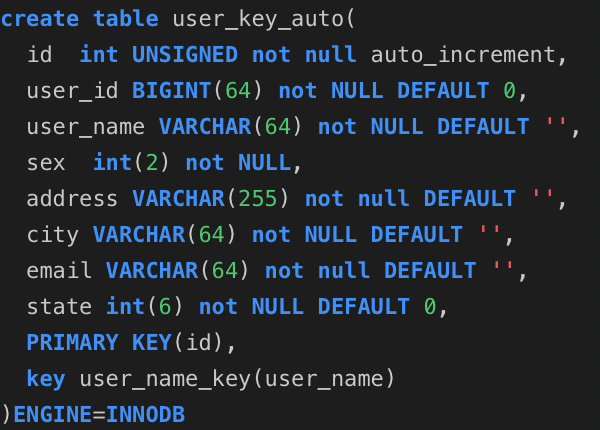
用户 uuid 表
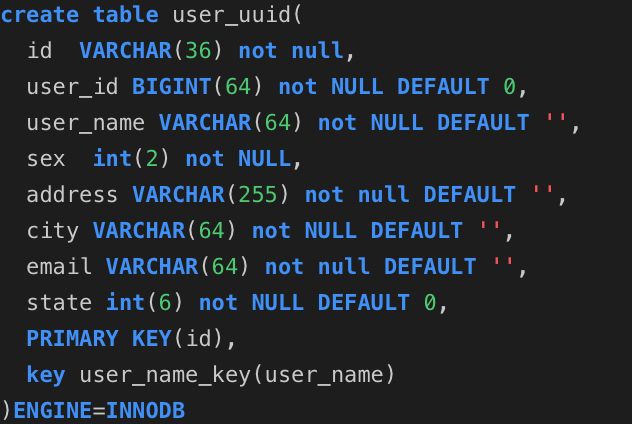
随机主键表:
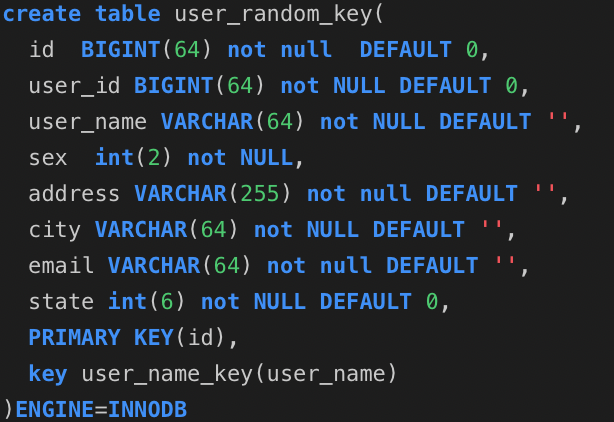
**1.2 光有理论不行, 直接上程序, 使用 spring 的 jdbcTemplate 来实现增查测试:**
技术框架:`springboot jdbcTemplate junit hutool`, 程序的原理就是连接自己的测试数据库, 然后在相同的环境下写入同等数量的数据,来分析一下 insert 插入的时间来进行综合其效率,为了做到最真实的效果, 所有的数据采用随机生成,比如名字、邮箱、地址都是随机生成,程序已上传自 gitee, 地址在文底。
```
package com.wyq.mysqldemo;
import cn.hutool.core.collection.CollectionUtil;
import com.wyq.mysqldemo.databaseobject.UserKeyAuto;
import com.wyq.mysqldemo.databaseobject.UserKeyRandom;
import com.wyq.mysqldemo.databaseobject.UserKeyUUID;
import com.wyq.mysqldemo.diffkeytest.AutoKeyTableService;
import com.wyq.mysqldemo.diffkeytest.RandomKeyTableService;
import com.wyq.mysqldemo.diffkeytest.UUIDKeyTableService;
import com.wyq.mysqldemo.util.JdbcTemplateService;
import org.junit.jupiter.api.Test;
import org.springframework.beans.factory.annotation.Autowired;
import org.springframework.boot.test.context.SpringBootTest;
import org.springframework.util.StopWatch;
import java.util.List;
@SpringBootTest class MysqlDemoApplicationTests {
@Autowired private JdbcTemplateService jdbcTemplateService;
@Autowired private AutoKeyTableService autoKeyTableService;
@Autowired private UUIDKeyTableService uuidKeyTableService;
@Autowired private RandomKeyTableService randomKeyTableService;
@Test void testDBTime() {
StopWatch stopwatch = new StopWatch("执行sql时间消耗"); /** * auto_increment key任务 */
final String insertSql = "INSERT INTO user_key_auto(user_id,user_name,sex,address,city,email,state) VALUES(?,?,?,?,?,?,?)";
List<UserKeyAuto> insertData = autoKeyTableService.getInsertData();
stopwatch.start("自动生成key表任务开始"); long start1 = System.currentTimeMillis(); if (CollectionUtil.isNotEmpty(insertData)) { boolean insertResult = jdbcTemplateService.insert(insertSql, insertData, false);
System.out.println(insertResult);
} long end1 = System.currentTimeMillis();
System.out.println("auto key消耗的时间:" (end1 - start1));
stopwatch.stop(); /** * uudID的key */
final String insertSql2 = "INSERT INTO user_uuid(id,user_id,user_name,sex,address,city,email,state) VALUES(?,?,?,?,?,?,?,?)";
List<UserKeyUUID> insertData2 = uuidKeyTableService.getInsertData();
stopwatch.start("UUID的key表任务开始"); long begin = System.currentTimeMillis(); if (CollectionUtil.isNotEmpty(insertData)) { boolean insertResult = jdbcTemplateService.insert(insertSql2, insertData2, true);
System.out.println(insertResult);
} long over = System.currentTimeMillis();
System.out.println("UUID key消耗的时间:" (over - begin));
stopwatch.stop(); /** * 随机的long值key */
final String insertSql3 = "INSERT INTO user_random_key(id,user_id,user_name,sex,address,city,email,state) VALUES(?,?,?,?,?,?,?,?)";
List<UserKeyRandom> insertData3 = randomKeyTableService.getInsertData();
stopwatch.start("随机的long值key表任务开始");
Long start = System.currentTimeMillis(); if (CollectionUtil.isNotEmpty(insertData)) { boolean insertResult = jdbcTemplateService.insert(insertSql3, insertData3, true);
System.out.println(insertResult);
}
Long end = System.currentTimeMillis();
System.out.println("随机key任务消耗时间:" (end - start));
stopwatch.stop();
String result = stopwatch.prettyPrint();
System.out.println(result);
}
```
**1.3 程序写入结果**
user_key_auto 写入结果:

user_random_key 写入结果:

user_uuid 表写入结果:

**1.4 效率测试结果**
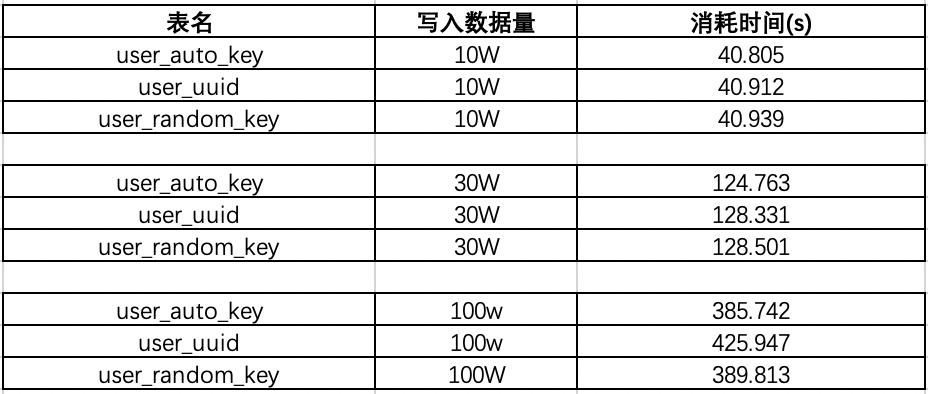
在已有数据量为 130W 的时候:我们再来测试一下插入 10w 数据,看看会有什么结果:

可以看出在数据量 100W 左右的时候, uuid 的插入效率垫底,并且在后序增加了 130W 的数据,uudi 的时间又直线下降。时间占用量总体可以打出的效率排名为:auto_key>random_key>uuid,uuid 的效率最低,在数据量较大的情况下,效率直线下滑。那么为什么会出现这样的现象呢?带着疑问, 我们来探讨一下这个问题:
### 二、使用 uuid 和自增 id 的索引结构对比
**2.1 使用自增 id 的内部结构**

自增的主键的值是顺序的, 所以 Innodb 把每一条记录都存储在一条记录的后面。当达到页面的最大填充因子时候 (innodb 默认的最大填充因子是页大小的 15/16, 会留出 1/16 的空间留作以后的修改):
①下一条记录就会写入新的页中,一旦数据按照这种顺序的方式加载,主键页就会近乎于顺序的记录填满,提升了页面的最大填充率,不会有页的浪费
②新插入的行一定会在原有的最大数据行下一行, mysql 定位和寻址很快,不会为计算新行的位置而做出额外的消耗
③减少了页分裂和碎片的产生
**2.2 使用 uuid 的索引内部结构**
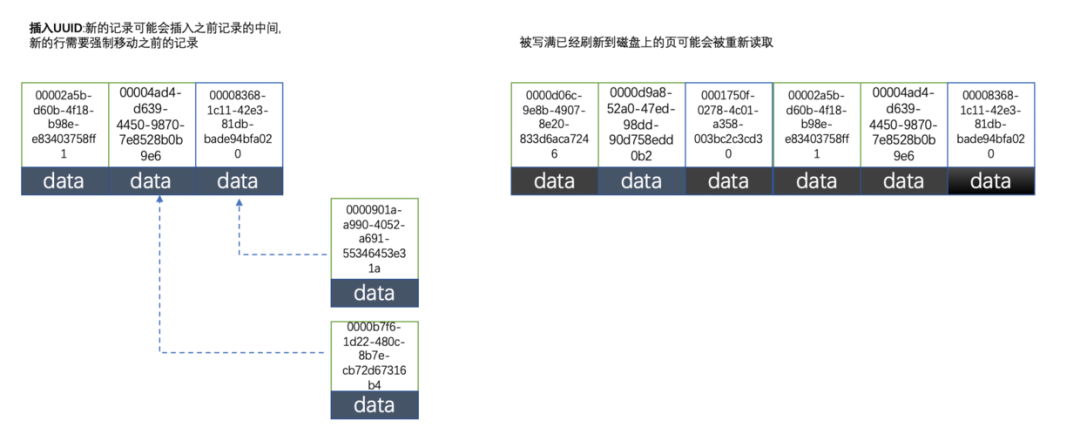
因为 uuid 相对顺序的自增 id 来说是毫无规律可言的, 新行的值不一定要比之前的主键的值要大, 所以 innodb 无法做到总是把新行插入到索引的最后, 而是需要为新行寻找新的合适的位置从而来分配新的空间。这个过程需要做很多额外的操作,数据的毫无顺序会导致数据分布散乱,将会导致以下的问题:
①:写入的目标页很可能已经刷新到磁盘上并且从缓存上移除,或者还没有被加载到缓存中,innodb 在插入之前不得不先找到并从磁盘读取目标页到内存中,这将导致大量的随机 IO
②:因为写入是乱序的, innodb 不得不频繁的做页分裂操作, 以便为新的行分配空间, 页分裂导致移动大量的数据,一次插入最少需要修改三个页以上
③:由于频繁的页分裂,页会变得稀疏并被不规则的填充,最终会导致数据会有碎片
在把随机值(uuid 和雪花 id)载入到聚簇索引 (innodb 默认的索引类型) 以后, 有时候会需要做一次 OPTIMEIZE TABLE 来重建表并优化页的填充,这将又需要一定的时间消耗。
结论:使用 innodb 应该尽可能的按主键的自增顺序插入,并且尽可能使用单调的增加的聚簇键的值来插入新行
**2.3 使用自增 id 的缺点**
那么使用自增的 id 就完全没有坏处了吗?并不是,自增 id 也会存在以下几点问题:
①:别人一旦爬取你的数据库, 就可以根据数据库的自增 id 获取到你的业务增长信息,很容易分析出你的经营情况
②:对于高并发的负载,innodb 在按主键进行插入的时候会造成明显的锁争用,主键的上界会成为争抢的热点,因为所有的插入都发生在这里,并发插入会导致间隙锁竞争
③:Auto_Increment 锁机制会造成自增锁的抢夺, 有一定的性能损失
附:Auto_increment 的锁争抢问题,如果要改善需要调优 innodb_autoinc_lock_mode 的配置
### 三、总结
本篇博客首先从开篇的提出问题, 建表到使用 jdbcTemplate 去测试不同 id 的生成策略在大数据量的数据插入表现,然后分析了 id 的机制不同在 mysql 的索引结构以及优缺点,深入的解释了为何 uuid 和随机不重复 id 在数据插入中的性能损耗,详细的解释了这个问题。在实际的开发中还是根据 mysql 的官方推荐最好使用自增 id,mysql 博大精深,内部还有很多值得优化的点需要我们学习。
附:本篇博客 demo 地址:https://gitee.com/Yrion/mysqlIdDemo


